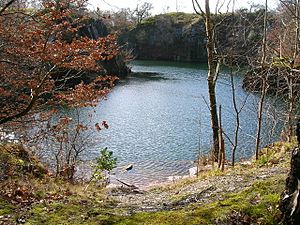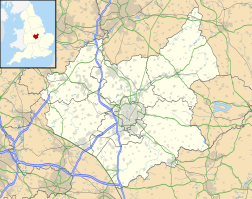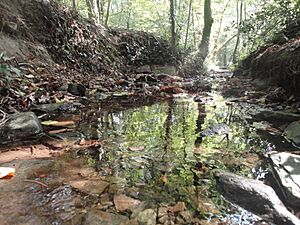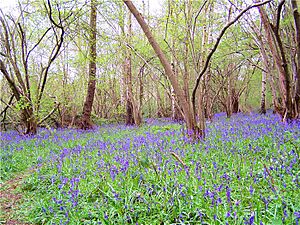Swithland Wood and The Brand facts for kids
| Site of Special Scientific Interest | |

Disused slate quarry in Swithland Wood
|
|
| Area of Search | Leicestershire |
|---|---|
| Interest | Biological |
| Area | 87.9 hectares (217 acres) |
| Notification | 1983 |
| Location map | Magic Map |
Swithland Wood and The Brand is a large natural area in Leicestershire, England. It covers about 88 hectares (217 acres) and is a special place for nature. It's officially known as a Site of Special Scientific Interest (SSSI) because of its important plants and animals. Swithland Wood is also famous for its ancient rocks and old slate quarries. It's located south of Woodhouse Eaves and is close to Bradgate Park.
Swithland Wood is a public forest in Charnwood Forest. Even though it's near the village of Swithland, most of it is actually in Newtown Linford. It's known as Leicestershire's most important ancient woodland for nature. Long ago, quarries in the wood provided special Swithland Slate. This slate was used for roofs on many local buildings. It was also used for gravestones in churchyards. Swithland Wood became a public woodland in 1925. The Leicester Rotary Club bought it to protect it. Since 1931, the Bradgate Park and Swithland Wood Trust has looked after it.
Contents
Ancient Woodland History
Swithland Wood is called an ancient semi-natural woodland. This means it has been a forest for a very long time. In medieval times, parts of the wood were cleared for farming. You can still see old "ridge and furrow" marks from these farms. But by 1512, some areas were already woodlands again. The trees likely grew back naturally on the abandoned farmland. Since then, it has always been a woodland. It was managed by a method called coppicing, where trees are cut back to the stump to regrow.
The woodland was divided into different sections with names like Great Lynds and Slate Pit Hill. For centuries, it belonged to the Grey family, who were the Earls of Stamford. They owned many woodlands as part of their Bradgate Estate. The name 'Swithland Wood' was first used in 1772. Today, this name covers all the Grey family's woodlands in this area. Next to the public wood are Stocking Wood and Whites Wood. These are private and are not open to the public. However, they are still part of the protected SSSI area.
The Famous Swithland Slate Quarries
Swithland Slate has been a popular roofing material in the area for a very long time. People have used it since Roman times! This special slate is found in a line of rock outcrops. These outcrops stretch from Hallgates through Swithland Wood and The Brand. You can also find them up to Woodhouse Eaves. All these places have old slate quarry pits. There are also quarries on the other side of Charnwood at Groby.
Swithland Wood has been quarried for many centuries. At first, it was for small amounts of slate. There are 24 small pits in the wood from this early quarrying. Later, two bigger quarries opened. One was the 'Great Pit' in the middle of the woods. The other was near the road at the north end. Four more water-filled pits are in The Brand, across Swithland Road.
By the mid-1800s, the Great Pit was very deep, over 55 meters (180 feet). Swithland Slate became popular for roofs around 1750. You can still see it on many old buildings in the area. Unlike thinner Welsh slates, Swithland Slate roofs have different sized slates. Smaller ones are at the top, and larger ones are at the bottom. This slate was even used on St Pancras railway station in London!
People also used Swithland Slate for gravestones since the 1600s. These gravestones are found in churchyards across Leicestershire. They are known for their detailed carvings that last a very long time. Other uses included kerbs, windowsills, and sinks.
When canals and railways made it easy to bring in cheaper Welsh slate, the demand for local slate dropped. Quarrying in the northern pit stopped in 1838. The Great Pit stopped production in 1887. Today, both pits are filled with deep water. They are fenced off to keep visitors safe. But you can still see great views of the pools and rock faces from paths. The Great Pit is sometimes used for scuba diving.
Swithland Wood for Everyone
After the quarries closed, the area was still an important forest. The Grey Estate continued to manage the timber and plant new trees. In 1921, the woods were sold to William Gimson. He then offered them to the Rotary Club of Leicester. The Rotary Club wanted to save these important ancient woodlands. They also wanted to make sure the public could always visit them.
A special charity was set up to raise money. They collected £6,000, which was a lot of money back then! This covered the cost of buying the woods. It also paid for new fences, tree care, and visitor facilities. The Rotary Club managed the park for seven years. There's even an inscription on the rock face of the Great Pit. It says, "The Leicester Rotary Club Secured Swithland Wood For A National Heritage."
In spring, Swithland Wood is famous for its beautiful bluebells. These flowers cover large parts of the forest floor. In 1927, the Rotary Club started an annual Bluebell Service. This special service is held by the Great Pit every April. It's a tradition that continues to this day.
In 1928, a businessman named Charles Bennion bought the larger Bradgate Park next door. He also wanted to protect it for the public. In 1931, the Rotary Club decided to combine Swithland Wood with Bradgate Park. This created the Bradgate Park and Swithland Wood Trust. Since then, the Trust has managed Swithland Wood. It remains open to everyone and is loved for its nature and for outdoor activities.
Why Swithland Wood is Special
Swithland Wood is a Site of Special Scientific Interest (SSSI). This means it's one of the best places in Leicestershire for certain types of woodland. It has important oak, lime, and alder trees. It's a great example of an ancient woodland on rich, loamy soils. The way Swithland Wood has been managed has helped many different plants grow. It has also allowed complex natural systems to survive.
Even with some changes over time, like the quarries or paths, the wood has stayed mostly the same. These changes have sometimes created new homes for different species. But overall, Swithland Wood has been a continuous forest for centuries. The main trees like oak, ash, lime, and holly have been there for hundreds of years. This long history has helped a rich variety of plants to grow. Swithland Wood has the highest "Flora Score" of any woodland in Leicestershire and Rutland. This means it has the most types of plants!
The Ancient Rocks of Swithland Wood
The very old rocks in Charnwood Forest were once flat layers on a seabed. About 420 million years ago, these layers were pushed up. This formed a dome shape, like a giant hill. Over time, the top of this dome wore away. This exposed older and older rocks. Swithland Wood is on the south-eastern edge of this ancient dome.
The Swithland Slates are some of the "youngest" of these very old rocks. For a long time, scientists thought they were from the Precambrian period. That would make them about 545 million years old. But recently, scientists found tiny trace fossils in the Swithland Slate. These are signs of animals burrowing in the mud. This discovery changed the dating! Now, all the rocks in this group are known to be from the Cambrian period. That means they are about 530 million years old. These trace fossils show that simple animals were living and moving in the mud. You can even see some of these trace fossils on old Swithland Slate gravestones, like those in Ratby churchyard.
The mud that became Swithland Slate was laid down on the seabed. It was very fine mud, which made the slate smooth and even. Later, more layers of sediment piled on top. The pressure and heat from these layers, along with the uplifting of the rocks, turned the mud into hard rock. The way the rocks were pushed up created natural cracks. These cracks are why the slate can be split into thin sheets for roofs.
By the Triassic Period, about 240 million years ago, the mountains had worn down. Then, new layers of desert sand and dust covered the area. This created the gentler, rolling hills you see today. The old rocks only poked out at the surface. Later, during the ice age, glaciers scraped away some of these layers. They exposed the tips of the older rocks again. When the ice age ended, patches of clay and boulders were left behind. You can find these in parts of Swithland Wood.
Visiting Swithland Wood
Swithland Wood is open to the public during daylight hours. You can park your car at the pay and display car parks. These are on Roecliffe Road and Swithland Road. You can also walk to the wood from near the Hallgates entrance to Bradgate Park. Inside the wood, there are special paths for horse-riding. There are also marked routes for cycling.
Images for kids







